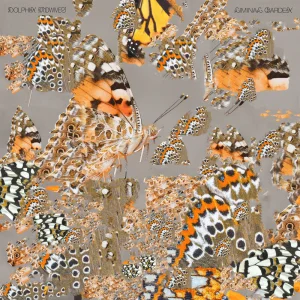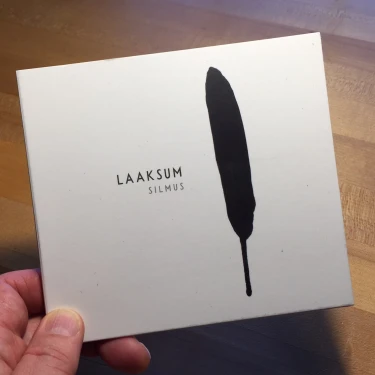Dolphin Midwives – Liminal Garden

Available Formats: LP & Digital
Time: About 40 minutes
Labels: Sounds et al: ETAL011 & Beacon Sound: BNSD031
Tracks: 1) Grass Grow, 2) Junglespell, 3) Castleshell, 4) Flux, 5) Temple IV, 6) Mirror, 7) Labyrinth I, 8) Temple V, 9) Satya Yuga, 10) Iridesce
From an early age I have been fascinated by the sound and look of a harp. While some watched the Marx Brothers for the comedy, I was waiting for the ritual of Harpo’s performance—the calm respite from the chaos. Later, it was Bach Partitas played by Nicanor Zabaleta and other harpists and ensembles, and then improvisations and atmospheres played by Andreas Vollenweider (who was unfortunately pigeon-holed in the ghastly ‘New Age’ record bins in the 1980s). Thank goodness there’s a new generation continuing to make music with their harps.
No matter the genre, hearing music from a harp can be a riveting and even a mystical experience. A harp can supplement the atmosphere of a larger work of music or it can stimulate on its own, generating inner subconscious reactions (as instrumental music tends to do). It can be abstract or symbolic—cascading water, sun in the clouds, soft gentle repetitions to calm or to be invited into another realm beside the present.
Sage Fisher composes and performs with a harp, percussion, effects, and her voice. She is an experimental sound artist from Portland, Oregon, and Dolphin Midwives is the name of her performance project. As far as I can gather Liminal Garden is her second full length album (Orchid Milk appears to be her first in 2016—available on her Bandcamp page). I think that Liminal Garden has mystical or spiritual references that I am not qualified to interpret (some mysteries are better left unsolved), but I speculate that this album is a journey of exploration in two episodes, whether it is experienced as a two-sided LP or as a continuous thread in a digital music stream.
Each of the two parts starts with an abstract centering and cleansing vocal prologue (Grass Grow and Mirror), where short themes are established and then altered with looping effects, samples and down and up octaves—a loosely narrated trip that gradually arrives at an altered state, where a sense of time can be lost. It could even be the beginning of an escape from our current unstable world condition. The two interconnected meditations then have sharp contrasts throughout—think of slipping from the comfort of a hot pool of water into the shock of one that is frigid. There is a momentary shudder, but then the realization that the entire experience is about an awakening of all the senses to understand and embrace the whole.
Once fully absorbed, Junglespell is a transition from a peaceful start into a star gate sequence akin to Bowman’s journey of enlightenment near the end of 2001 A Space Odyssey. Here there is no vocal to guide, and there is a transformed sense of perception leaving subconscious thought to interpret. Not only is the sound entrancing, but watching it being created is equally as fascinating.
Once released from Junglespell, a slow awakening begins in Castleshell, arriving somewhere else, perhaps a bit dazed from a dream, out the other side of that star gate. The sharp contrast of Flux stimulates other parts of the mind that have been quietly idle. There is an electric energy of realignment, a jarring altered-state glitchy repetition. Then balance returns in the absorbing Temple IV with short tangible loops and a short melody that meanders within a tight range.
Part two of the journey is somewhat different and is introduced with Mirror. It has layered cascading vocals in varying octaves altered with electronic effects, octaves and loops. Rather than continuing on into a hypnotic state, another contrast is entered in Labyrinth I, which is disorienting with stimulus from all sides, seeking and not finding a way out. From the cold pool to the warm, the immersive and enveloping Temple V’s melodic percussion reminds me of Kraftwerk’s Klingklang (Kraftwerk 2 – 1972). Then there is a clear return of the harp with a gentleness and purity of the enlightening Satya Yuga, a respite of reflection and balance from the prior experiences. The epilogue to the album is Iridesce, a colorful stuttering of altered voices and electronics.
One cannot know the calm without experiencing the chaos. On what mesmerizing journey will Sage Fisher take us next?
The album was recorded by Jason Powers, and mastered by Rafael Anton Irisarri (Black Knoll), and the artwork is by Bijan Berahimi.
****
This is a solicited review.
Silmus – Laaksum
Volkoren 82 – CD Time: 43:53
1) Laaxum 2) Dancing On The Pier, Discovering The Sea 3) Hectanred 4) The Spirit of Morning Light 5) Raise Up 6) Meeting At Stonerow 7) Silence Is Black 8) Sacred Place 9) Wintering 10) Lay Myself Down
Gert Boersma (electric guitars, bow, khim, bass, melodica, harmonica, synthesizers, percussion, samples, effects and field recordings) is from the Netherlands, and is supported by musicians Jan Theodoor Borger (piano and effects), Minco Eggersman (drums, percussion), Guy Gelem (cello), and Mirjam Feenstra (vocals)
It’s been almost five years since we’ve heard from Gert Boersma of Silmus, but in the contemplative realm, seeking inspiration and summoning creativity can be an unpredictable long-term pursuit, and so, our patience is now rewarded.
There is a certain degree of speculation in reviews like these, but I feel relatively confident that Laaksum is inspired by evoking and honoring memories of a place, and I perceive that they are generally fond and formative recollections. The album is a sonic memoir of sorts, a solitary contemplation, and it delicately hovers between reverence and melancholy, but it is bereft of sentimentality.
Laaksum, the place, where I have never been, is on the shore of a remote inland bay in the province of Friesland, in north of the Netherlands, and is well-protected, apparently peaceful and a place where time might seemingly stand still. Memories are an inner form of time travel, and can return with seeing or holding an object, smelling a fragrance or hearing a sound—and any one can evoke all the others. I’m guessing, judging by the cover illustration that it starts with the appearance of a feather, and then what returns are the memories of the time spent at the jetty, the stand of trees, seeing flocks of seabirds, all of which are depicted in photographs and are the inspiration for the artwork within the tri-fold sleeve and booklet of the CD, envisioned with minimal embellishment by Daniel Thomassen.
Laaksum, the album, is mostly delicate, warm and peaceful. It’s impeccably recorded with a clarity and crispness of a clear noon sky in Spring—an auditory purity that is not overly precious. The instrumentation is widely varied, mostly acoustic, woody, but when it’s lush, it’s not self-indulgent. Boersma has taken great care in conveying his perception of that place from another time. It is a welcome and contemplative meditation in our current rather thoughtless and unsettled period in our collective history, an escape.
Laaxum, the track, seems to be symbolic of the catalyst where the memories return, but it is apparent that there are no storms here; mostly calm waters as those appearing in Dancing On The Pier, Discovering The Sea. The melodies in Hectanred are teased and appear as short tonal mantras—caught and then released, fleeting as a daydream lost in the ether. There are momentary diversions of perceived mystery or tension, as in Meeting At Stonerow or the ancient sounding Silence Is Black with occasional microtonal notes and dissonant chords, but overall the comfort and warmth prevail. The Spirit Of Morning Light has perhaps the most tangible clarity, as the rising sun reveals the sights and colors of the day.
As the seasons change, Wintering has both the layered vocal chill of the outside, but the comfort of a warm stringed suite on the inside. The epilogue, Lay Myself Down is perhaps an overall reflection, where the flood of the many years past is at first unclear and drifting, until a calm and clear melody gently presses through, where the memories from long ago become sorted and clarified, and where they can be forever held and retold.
****
This is a solicited review.

